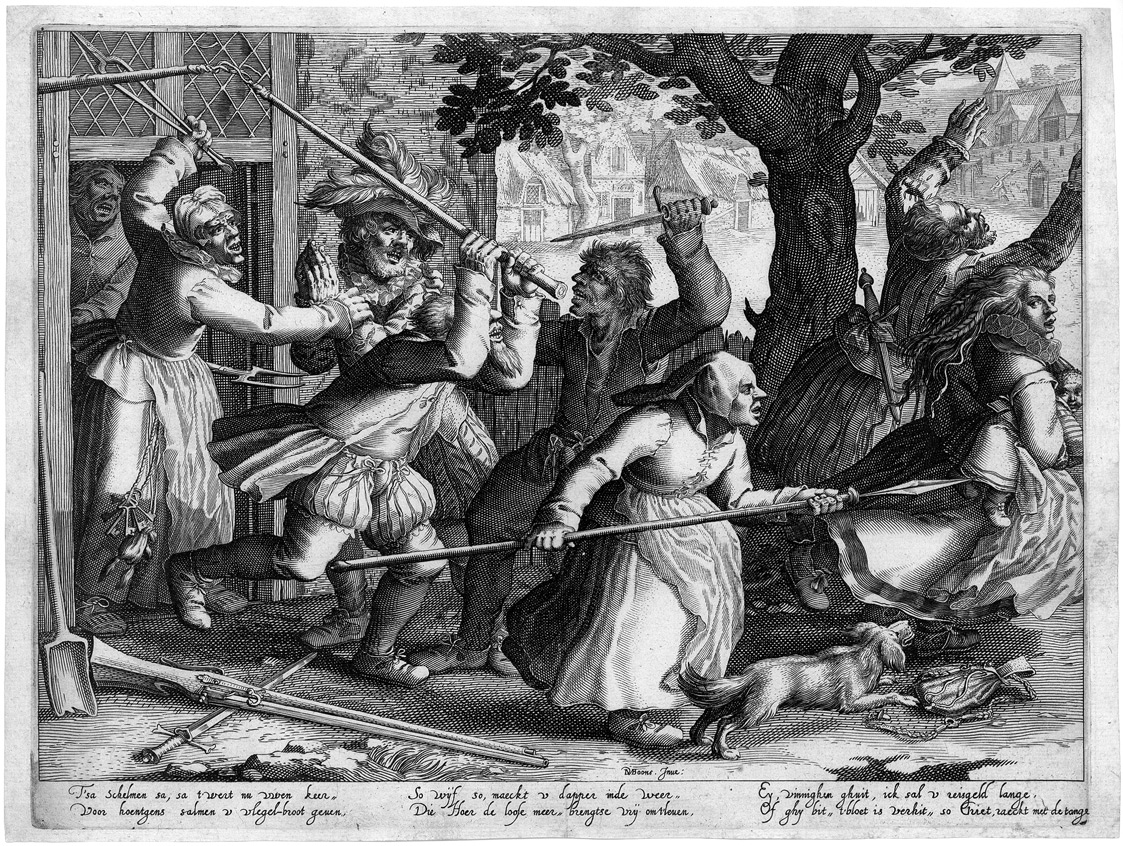Loading the page ...
Boetius Adams Bolswert
(1580 Bolsward – 1633 Antwerp)
Boereverdriet (Peasant’s Sorrow). Set of four engravings after David Vinckboons. Each ca. 21.8 x 28.5 cm. (1610). Hollstein 314–317 I (of II). Watermark: Pot with Flower and Crescent (Hollstein 317) and countermark (H. 314–316).
The suite is based on originals by the Flemish painter David Vinckboons, whose Protestant faith prompted him to move from Antwerp to Amsterdam in or around 1591. Two preliminary drawings for the first and third print of the set are in the Musée du Louvre in Paris, while two iconographically related small oil paintings are kept in the Rijksmuseum in Amsterdam. The suite depicts with a wealth of detail and subtle irony the suffering and harassment of the peasant population during the period of the Eighty Years’ War. Instead of showing an event that really took place, however, the scenes are meant to be understood in a figurative sense as a symbolic portrayal of the violence of human nature and the absurdity of human existence. Their iconography and content are closely bound up with the moralizing plays of the “rederijkers” (rhetoricians) and with the folk songs and popular writings of the early 17th century. The commenting verses indicate that the cycle was intended by the author to be an allegory of the twelve-year truce between the Netherlands and Spain (1609–1621).
On the title page gaudily costumed mercenaries, bent on plunder and accompanied by sutlers and harlots, are violently breaking into a peasant’s house. The theme of violence, which the simple peasant population was doomed to endure in times of war, is a pictorial tradition which found its first artistic expression in the early 16th century in the prints of the so-called German Little Masters, such as Albrecht Altdorfer, Hans Sebald Beham, and Georg Pencz. It was a subject soon taken up in the painting of Flemish masters as Pieter Brueghel, Sebastian Vranckx, and Roelant Savery. The second scene in the series has as its leitmotiv the horrors of war and portrays a further escalation of violence. The marauders and their expensively dressed companions have made themselves at home around a well-stocked table in the peasant’s parlour and are feasting. One of them, however, is clearly dissatisfied with the fare on offer and holds his dagger aloft threatening to kill the peasant kneeling fearfully in the foreground, while his comrade pursues the peasant’s wife with upraised sword. The scene reveals an abundance of wonderfully observed details: the lovingly depicted interior with the numerous humble attributes of everyday life; the luxurious clothing of satin, lace and feathers worn by the soldiers especially, which is opulent to the point of parody; the minutely rendered dishes on the table; and the still life of shattered crockery, heedlessly discarded bones and leftovers on the floor in the foreground. The third print, however, shows an unexpected turn of events. The oppressed take their revengeand drive out the uninvited guests with violence that is no less brutal, so that the boerenverdriet (peasant’s sorrow) becomes the boerenvreugd (peasant’s joy). Significantly enough, and not without a touch of sly mockery, it is the peasant’s wife who is shown leading the assault armed with a lance, an iconographical point illustrating the then popular theme of the “World Upside Down” while at the same time denouncing the cowardice of the foppishly dressed mercenaries. The final print in the series provides the catharsis of the tragicomedy: Peasants and soldiers, oppressed and oppressors, have become reconciled and are sitting peacefully together. The image is full of symbolism showing up the absurdity of human behaviour. In the left foreground a peasant’s wife suckles the child of one of the soldiers’ paramours, while the peasant drinks a toast to one of his former tormentors. The text of the accompanying verse may be freely translated as follows: “Look now how the Truce turns everything upside down / The cruel soldier sits down with the peasant /Now it’s “To you, soldier of fortune, to us, comrade” … / Come, sit with us and let’s indulge / The foolish peasant kisses the harlot, why shouldn’t we have a dance?” Peace seems to be restored, but for how long? A small detail in the right foreground suggests that hostilities could soon break out again, as one of the harlots steals a peek at the cards of one of the peasants. In a way which is quite in keeping with the moral thinking of the 17th century this subtle element of narrative points to the imponderabi lity of the conditio humana that is illustrated in the events shown. The real message of the final scene is that all human endeavour is subject to a fragile balance, and drinking, gaming and dancing are activities which can all too easily lead to conflict (for an exhaustive interpretation of the iconography see Jane S. Fishman, Boerenverdriet. Violence between Peasants and Soldiers in Early Modern Netherlands Art. Berkeley 1979, pp. 31–44).
Superb, exceptionally contrasting and strong early impressions with even margins around the platemark, before the numbers. Minimal aging, otherwise in excellent condition. The complete set is extremely rare.
